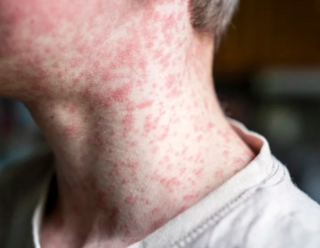- About 1 in 5 unvaccinated people with measles must be hospitalized.
- People at higher risk for measles complications include children under age 5, adults older than age 20, pregnant women, and the immunocompromised.
- Severe complications may include pneumonia and brain swelling; about 1 to 3 of every 1000 infected children die of such complications.
- Survivors may be left blind, deaf, or with a new intellectual disability.
The measles vaccine is safe and extremely effective.
- Before the vaccine was introduced, measles resulted in 48,000 hospitalizations and up to 500 deaths in the United States every year.
- The two-dose measles vaccine, given at age 12-15 months and again at age 4-6, provides nearly complete (97%) and typically lifelong protection against infection.
- Some parents are hesitant to vaccinate their children; their concerns are often magnified by misleading claims on social media. In fact, the risks of serious measles infection—hospitalization, pneumonia, brain swelling, long-term complications—far exceed the risk of vaccination.
Should adults get measles boosters?
For most, it’s unnecessary. The following people are considered immune and do NOT need boosters:
- People born before 1957.
- Those with a history of measles as a child.
- Those with documentation of 2 doses of vaccine 28 days apart or with documented positive serology.
The following people could consider a booster dose of the measles/mumps/rubella (MMR) vaccine through a healthcare provider. If needed, a booster is safe regardless of prior vaccination:
- Those who are unsure of their vaccination status (do try to find those old records).
- Those vaccinated between 1957 and 1968, when an ineffective vaccine was in use.
- Those unsure of vaccination status or at increased risk due to immune compromise who must travel to western Texas or another area where there is an active outbreak (such travel should be avoided if possible).
- Infants in families traveling to an outbreak setting or internationally, who may be vaccinated as early as 6 months of age.
People who have never been vaccinated should get two vaccine doses at least 28 days apart. Note that a small group should not be vaccinated with MMR: those with a documented allergy, with severe immune compromise, or women who are pregnant.
Coughs are still in season
Respiratory viruses—especially flu—continue to sicken Americans. Both the nation and Connecticut are still seeing high levels of emergency visits for influenza, but numbers are finally trending down. Yale Health saw a peak in February, when nearly half of samples were positive for flu; last week, 19% of samples tested positive for flu, compared with 6.3% for respiratory syncytial virus (RSV) and only 1.6% for COVID. Of note, we are seeing an increase in influenza B at 9.5% positivity, which commonly happens late in the season.
This flu season was the worst since 2017-2018, with 480,000 hospitalizations and 21,000 deaths. While rates are now decreasing, the Centers for Disease Control and Prevention (CDC) expects several more weeks of flu activity.

